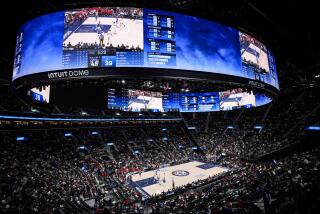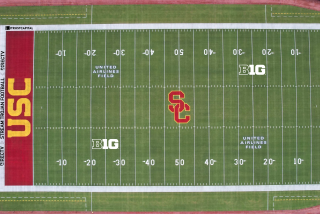City Searching for Answers for Financially Troubled Hall
- Share via
SOUTH BEND, Ind. — Consultants made rosy predictions that more than 140,000 people would visit the College Football Hall of Fame in its first year.
Corporate sponsors were expected to pay for the $14.5 million brick-and-glass building that was supposed to revitalize South Bend’s downtown.
But the sponsors didn’t develop, delaying construction by 10 months, and tourists didn’t exactly flock to the hall. Now the city is budgeting more than $1.32 million a year to pay for it.
“You make decisions that you hope are right by going through a process that you believe will lead you to make a good decision,” said Lt. Gov. Joe Kernan, mayor when the hall opened. “I believed we were doing the right thing.
“We never imagined that the hall would face the kind of challenge that it has.”
The city was so optimistic officials even told the National Football Foundation, which owns the hall’s exhibits, it wouldn’t need to pitch in a single cent. But saddled with a financial burden it never expected, some city officials are looking to the NFF for help.
Last month, the City Council even removed the hall’s budget from its own in an effort to gain leverage with the foundation, which has chipped in $1.3 million over the last three years despite the original agreement.
The city also has started over in its efforts to market the hall, which opened in 1995.
“It takes time no matter how much money we’re spending to let people know we’re in South Bend,” said Bernie Kish, the hall’s executive director. “Once people come here, they become our ambassadors.”
The city and NFF once thought word of mouth and a shoestring marketing budget would be enough to promote the hall. They didn’t even hire a full-time marketing director until 16 months after it opened.
But their mistake showed as attendance came up 18,000 short of the first year’s projected 140,000. Just less than 72,000 visited last year, and officials expect the same turnout for 1999.
The puzzling thing is no one seems to know why the hall hasn’t lived up to predictions.
With its interactive displays that include agility drills, kicking and throwing contests, and coaching strategy tests, the hall is not just a collection of dusty sports memorabilia.
Visitors can even pay $5 for a video of themselves in a broadcast booth doing play-by-play to Doug Flutie’s famous pass in the 1983 Boston College-Miami game or Cal’s amazing kickoff return through Stanford’s defense--and its band--in 1982, among others.
“This hall of fame is the best one that I’ve ever seen,” said Jim Host, whose Lexington, Ky.-based marketing firm was hired last year by the NFF to raise the hall’s profile. “It was built right. The people who run it do a great job. I think we just have to market it better.”
The hall has made some progress in that area, persuading more than 100 colleges to give it free publicity by running a public service announcement during football broadcasts and publishing ads in game programs.
They’ve also redone their traveling exhibit this year with a brand-new recreational vehicle, and the hall is trying to raise money at campuses. A golf outing during Kentucky’s celebration last month for former coach Jerry Claiborne, elected to the hall this year, raised about $10,000.
There’s also a renewed push for corporate sponsors, with an emphasis on giving them advertising opportunities.
“What we’re looking for are mutually beneficial opportunities for the sponsors,” Kish said.
Hall officials are hoping their efforts will pay off for them as much as they did for the Pro Football Hall of Fame.
The hall in Canton, Ohio, had 63,000 visitors its first year before jumping to about 80,000 in 1969 and topping out at more than 330,000 in 1973. Hall spokesman Joe Horrigan said that since then, the hall has averaged between 200,000 and 220,000 visitors a year while it constantly tries to find new ways to publicize itself.
But even if attendance skyrockets in South Bend, the revenue won’t come close to covering the $1.32 million the city is budgeting annually to cover the bonds issued to finance construction.
The city’s financial burden could increase in 2006, when it expects to budget $3.2 annually for the bonds. The payments would escalate further in the last three years of the 25-year bond unless the city refinances.
That’s led to gripes on the City Council that it’s been had by the NFF. The accusations irk its president Bob Casciola, who’s quick to point out no one forced the city to bring the Hall of Fame to town and that the foundation has done its best to help out.
“It’s not like the foundation has run away and hid and not accepted any responsibility,” he said.
Still, Mayor Stephen J. Luecke said he expects the city to renegotiate its agreement with the foundation to include a formal commitment of financial support.
No matter what happens, the city still has millions to pay off on the hall.
“We have that debt whether the hall stays in operation or not,” said Luecke.
More to Read
Go beyond the scoreboard
Get the latest on L.A.'s teams in the daily Sports Report newsletter.
You may occasionally receive promotional content from the Los Angeles Times.










